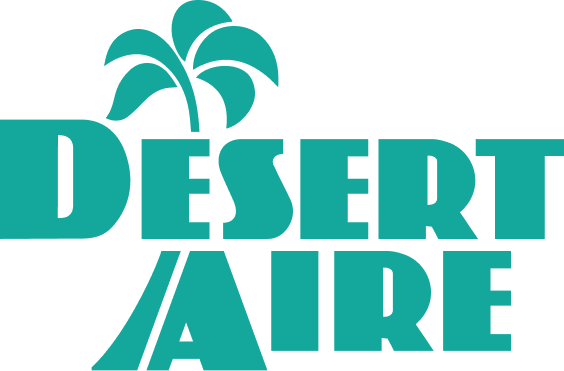
Indoor Pool Ventilation System Requirements | TB05
This technical bulletin reviews the outdoor air ventilation requirements for indoor swimming pool enclosures.
Gated Content Overview Headline
Lorem ipsum dolor sit amet, consectetur adipiscing elit, sed do eiusmod tempor incididunt ut labore et dolore magna aliqua.
Ut enim ad minim veniam, quis nostrud exercitation ullamco laboris nisi ut aliquip ex ea commodo consequat. Duis aute irure dolor in reprehenderit in voluptate velit esse cillum dolore eu fugiat nulla pariatur. Excepteur sint occaecat cupidatat non proident, sunt in culpa qui officia deserunt mollit anim id est laborum.
Gated Content
Please fill out the form for access.
Introduction
This technical bulletin reviews the outdoor air ventilation requirements for indoor swimming pool enclosures. It provides in-depth analysis of what the existing standard means and how ventilation air should be introduced to the air handler/dehumidification system. A review of energy recovery and conservation is also included.
As with all rules and regulations, interpretations vary. Desert Aire has provided the following summary in order to address the issue of ventilation air. This bulletin is for discussion only and is not intended to overrule the opinion of the consulting engineer.
ASHRAE Standards and Pool Ventilation Unit Air Volume
ASHRAE Standard 62.1-2022, the industry accepted ventilation code for indoor air quality, defines the minimum volume of outdoor air which must be introduced into the indoor pool enclosure. This volume is generally only a small percentage of the total air volume required by a dehumidification system to maintain the space humidity. Air velocities across the pool surface should be minimized to avoid excessive evaporation. The design of the dehumidifier should target approximately four to six air changes per hour.
Ventilation Air Standard |
|
Pool & Wetted Deck Area: |
0.48 cfm/ft2 |
| 2.4 l/s/m2 | |
Non-Wetted Deck Area: |
0.06 cfm/ft2 |
| 0.3 l/s/m2 | |
Spectator Area: |
7.5 cfm/spectator + 0.06 cfm/ft2 |
| 3.8 l/s/spectator + 0.3 l/s/m2 | |
ASHRAE 62 requires a ventilation air volume of 0.48 cfm per sq. foot of pool and wetted deck area plus 0.06 cfm per sq. foot of non-wetted deck area. In addition to this volume, an additional amount is required if the facility has a dedicated spectator area (bleachers). For these facilities, 7.5 cfm per person needs to be introduced in addition to 0.06 cfm per sq. foot of spectator area floor space during times that spectators are present.
Defining Pool and Deck Area for Ventilation
Wetted Deck area is defined in ASHRAE 62 as the area surrounding the pool that would be expected to be wetted during normal pool use. Dedicated Spectator areas are not included in the Wetted Deck Area. Locker rooms, vestibules and hallways are not included in this measurement. Note that Non-Wetted Deck Area is not the same as Wetted Deck Area (See Figure 1.)
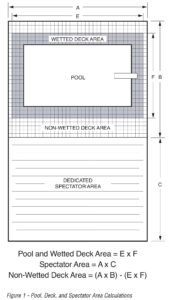
Water Chemistry and Odor
When planning natatoriums, designers are concerned about preventing any unpleasant odors. Typically, they design a ventilation system which brings in an excess amount of outdoor air in order to control any potential odor problems. While a complete analysis of pool water chemistry is beyond the scope of this bulletin, a quick review is required to eliminate some myths with respect to ventilation air requirements. Refer to Desert Aire Technical Bulletin #9 for a more detailed explanation of pool water and air chemistry.
Many people often complain about a strong, objectionable “chlorine” odor found in pool rooms. Actually, this odor is not chlorine (which cannot be smelled by humans until it is above toxic levels), but an intermediate compound formed during the disinfection process. The odor is produced by the combination of chlorine and organics (sweat, oils and urine) in water. What we smell are chloramines, which are volatile. They are readily released to the air and are detectable by humans at low concentrations.
Chloramines are heavier than air so the use of a low exhaust has proven effective for the removal of chloramines. Removing the odor causing chloramines at their source has improved the air quality in the natatorium and is a recommended solution by many designers for odor reduction and improved air quality. Refer to Desert Aire’s 21st Century Natatorium Design Guide on suggested air distribution and exhaust layout for the improvement of indoor air quality.
Interpretation of the Ventilation Code
The standard exists to protect the health of pool users. Proper interpretation, however, can also enhance energy conservation by reducing the volume of outdoor air required to the minimum allowed by code.
The interpretation is based on the following assumptions:
- that normal pool user load is small and spectator crowds will be handled as an exception;
- that automatic chemical feed systems are installed and operational; and
- that a dehumidifier is installed and operational.
Ventilation may be regulated based upon occupancy. When the facility is unoccupied, outdoor air flow may be discontinued. During normal operation, outdoor air flow may be set to a minimum code-approved level. For higher-than-normal occupancy (such as a swim meet), an increased outdoor
air flow rate is engaged. (See Figure 2.) Optimizing outdoor air will have a dramatic effect on operational heating and cooling costs.
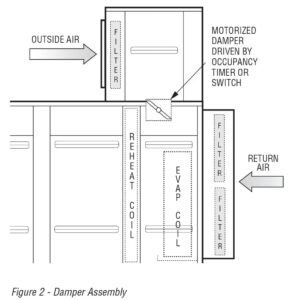
The control of outdoor air dampers can be accomplished in two ways: a manual switch or a timer.
For either of these two actuation methods, the system will establish three control points to automate the outdoor air damper: closed for unoccupied conditions; minimum code ventilation for normal activity; and an event mode to handle spectator load requirements. Additional indexing of the OA damper may also be established such as a Max OA Mode or Purge Mode.
Spectator occupancy is not constant in most facilities except during swim meets. Spectator ventilation air can be introduced by a dedicated outdoor air system (DOAS) that has its duct work deliver spectators with clean, fresh air. The DOAS can also produce temperatures that are a couple of degrees lower than the pool space temperature to help keep fully clothed spectators cooler. To further reduce energy costs, the code ventilation for this area can be controlled via a manually activated switch or a building management system with a scheduling program. In this way the facility can reduce its energy costs by conditioning the air only when spectators are present.
Introduction of Outdoor Air and Exhaust Requirements
The dynamics of a pool enclosure are unique because of the need for humidity control. Most other applications can accept outdoor air upstream of the air handler without affecting the system’s performance. This is not true in the case of a dehumidifier. If outdoor air is introduced into the return air duct, two problems can occur in cold weather (winter). The first problem is condensation in the duct when cold air meets the moist return air from the pool room. The second problem is that the mixed air temperature will be lower than the pool return air and will decrease the moisture removal capacity of the dehumidifier.
To eliminate these problems, the outdoor air should be introduced downstream of the evaporator (see Figure 3.) Then the dehumidifier has maximum moisture removal capacity and the reheat and auxiliary heating coils can raise the temperature of the outdoor air, avoiding cold drafts to the swimmers.
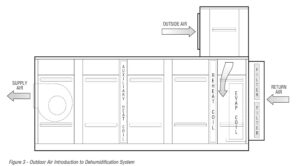
Economics of Heating and Cooling
WINTER
An indoor pool enclosure has several sources of energy loss:
- convection through the ceiling, windows, and walls
- exhaust air
- evaporation of the pool water
The convection heat loss and the exhaust air heat loss in a pool enclosure is a function of the coolness of the outdoor air temperature. The greater the temperature differential between indoor and outdoor, the greater the loss of energy. Uncontrolled heat loss causes swimmer discomfort and also increases the pool water evaporation rate. Heat loss through ceilings, walls, and windows can be minimized by using adequate insulation and multipaned windows. Heat loss through exhaust air can be minimized by eliminating exhaust during unoccupied times and by bringing in the minimum amount of outdoor air that code permits.
The water’s heat loss can be minimized by maintaining the air temperature at several degrees above the water temperature. A key factor is maintaining the room relative humidity at 50-60 percent. Should the relative humidity drop below 50 percent, the evaporation rate will increase significantly. Relative humidity below 50 percent can occur when extra amounts of outdoor air are introduced in the wintertime.
The simplest method to calculate the effects of ventilation is the total enthalpy method. This method compares the difference in enthalpy (BTU/lb) of indoor versus outdoor air at different ventilation rates. A direct energy cost can then be calculated.
SUMMER
During the summer months, heat gain – not loss – is a problem. A higher volume of outdoor air increases the cooling demand and introduces extra moisture in most climates. The increased load requires a larger sensible cooling capacity, and the increased moisture requires a larger dehumidifier that must run longer. This effect must be included in the dehumidifier sizing calculation.
Conclusion
A dehumidification system in an indoor pool facility not only protects the structure and recovers energy, but it also allows a reduction of outdoor air, thereby increasing energy savings. If your state has adopted ASHRAE 62 ventilation codes, then the following design specifications should be incorporated into your plans:
- Dehumidification system – designed to provide four to six air changes per hour while maintaining a relative humidity of 50 percent to 60 percent.
- Automatic chemical feed system – designed to eliminate the need to introduce extra outdoor air to control the odor of treatment chemicals.
- Provide the base ventilation air during normal usage, and base plus the spectator ventilation rate during swim meets.
- Outdoor air introduced after the evaporator coil in the pool dehumidifier -maximizes the capacity of the unit. A DOAS can be used for the spectator outdoor air volume.
- Use of Source Capture Exhaust in order to maintain indoor air quality while minimizing the OA volume.
View our different indoor pool ventilation units below. Questions on ventilating your indoor pool? Don’t hesitate to contact us for expert guidance. For more info on indoor pool ventilation systems, visit our indoor pools or indoor pool dehumidification systems page. At Desert Aire, we have solutions not just for pools, but many other applications as well. Learn more about our dehumidification and ventilation systems for many different dehumidifier offerings besides for indoor pools.
Share or Download
Ask A Question
Related Products
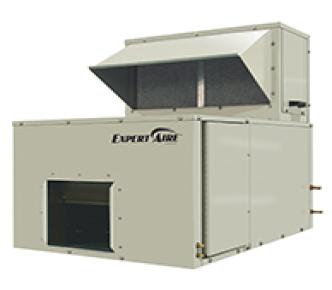
ExpertAire Horizontal (LC), Vertical (LV) & Packaged (LCQ) Series Dehumidifier
Designed for high efficiency and long life, Desert Aire’s ExpertAire™ commercial dehumidification ...
View Details
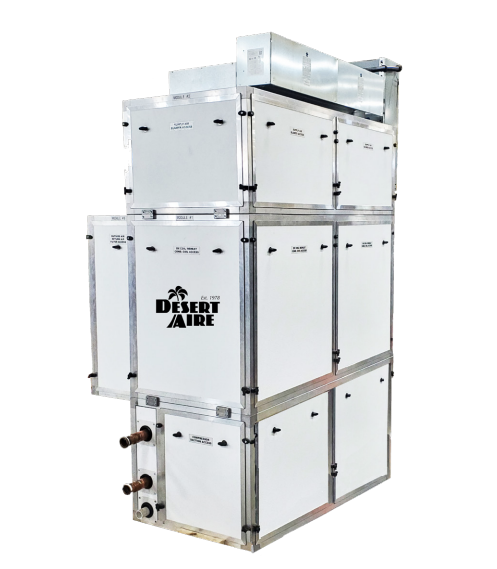
SwimAire™ Series Dehumidifier
With 39 to 112 lbs/hr of moisture removal capacity, 3,000 to 8,500cfm of air handling and 8 to 23 tons...
View Details
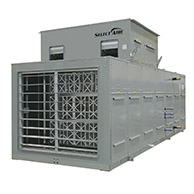
SelectAire™ Series Dehumidifier
The SelectAire™ commercial dehumidification systems are ideal for large-scale moisture removal appli...
View Details
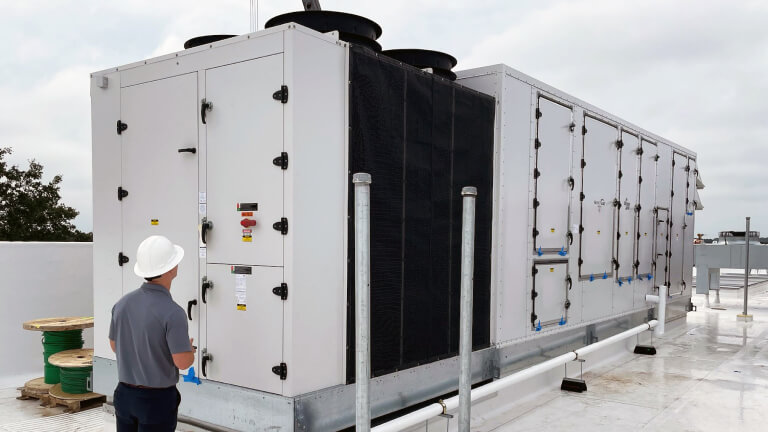
SelectAire Plus™ (SP) Series Dehumidifier
Designed specifically for large 50 meter pool applications, the SelectAire Plus™ Series modular dehu...
View Details
Find a Desert Aire Sales Rep Near You!
Our network of independent representatives are fully trained on Desert Aire’s dehumidification and DOAS solutions and can assist you in designing and sizing your engineered solutions.
